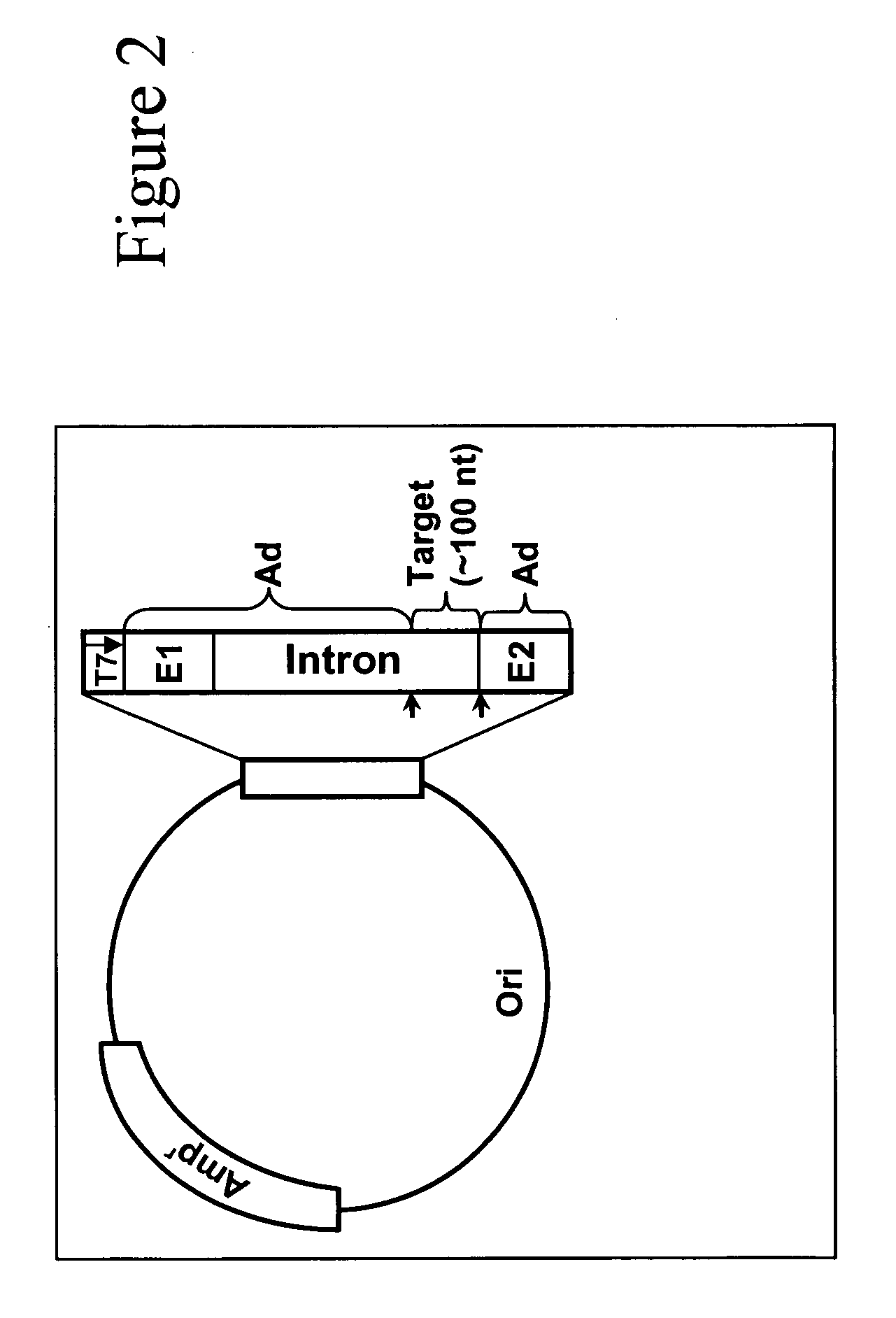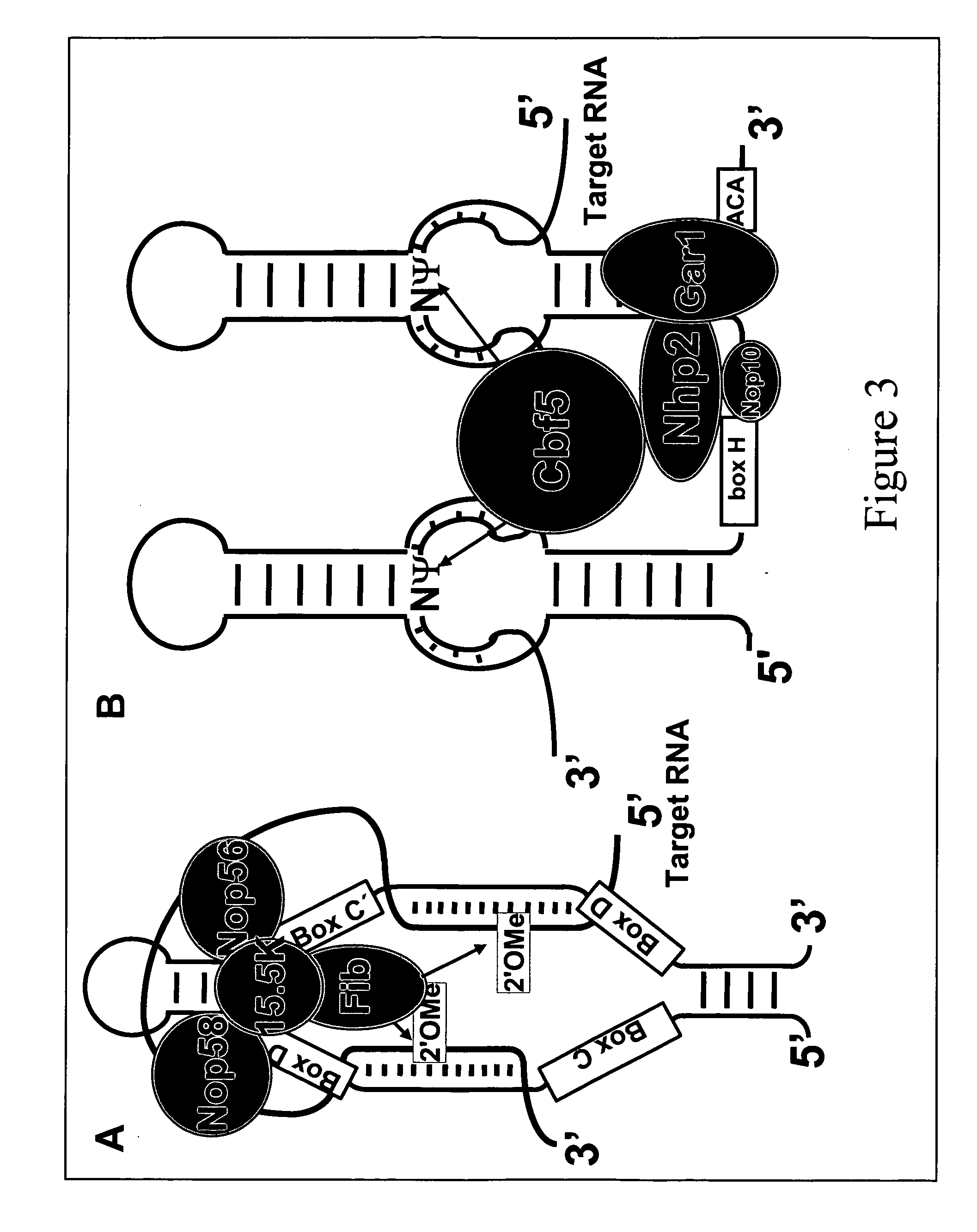Targeted pre-mRNA/mRNA modification and gene regulation
a technology of gene regulation and mrna, which is applied in the field of targeted premrna/mrna modification and gene regulation, can solve the problems of unintended toxic side effects, limited long-term therapeutic use of odns, and high concentration of odns, so as to facilitate the identification of branch points, prevent splicing, and prevent transcript maturation and subsequent expression
- Summary
- Abstract
- Description
- Claims
- Application Information
AI Technical Summary
Benefits of technology
Problems solved by technology
Method used
Image
Examples
example 1
A Small Nucleolar RNA (snoRNA) Guides U2 snRNA Pseudouridylation in S. cerevisiae
[0081] Yeast U2 snRNA contains three pseudouridines (Ψ35 , Ψ42 and Ψ44, which are equivalent to Ψ34, Ψ41 and Ψ43 in vertebrate U2 snRNA) within or near the branch site recognition region. It was previously shown that the formation of Ψ35 and Ψ44 is catalyzed by the protein enzymes Pus7p and Pus1p, respectively (Ma et al., EMBO J, 22:1889, 2003; Massenet, et al., Mol Cell Biol, 19:2142, 1999), but the mechanism for catalyzing Ψ42 formation was unknown. By analogy, it was widely believed that Ψ42 formation was also catalyzed by a protein enzyme alone, in the same manner as eukaryotic tRNA modifications. Given our access to the yeast GST-ORF fusion protein library (Phizicky, Methods Enzymol., 350:546, 2002), we screened for the enzyme for this remaining pseudouridine. Surprisingly, an activity screen identified a Ψ42-specific pseudouridylase activity that was associated with Nhp2p, one of the four core pr...
example 2
Artificial Box H / ACA RNAs can Guide Yeast U2 snRNA Pseudouridylation at Novel Sites in Vivo
[0084] On the above data showing that snR81 box H / ACA snoRNP catalyzes U2 pseudouridylation at position 42, the possibility that artificial guide RNAs, when introduced into yeast, can guide the pseudouridylation of U2 and perhaps the other spliceosomal snRNAs at novel sites was further explored. This method would not only prove that the artificial guide RNA is in fact functional, but also provide a powerful tool for functional analyses of spliceosomal snRNA modifications.
[0085] It was first tested whether an artificial U2 pseudouridylation-specific guide RNA could be expressed in yeast and whether its expression could direct U2 pseudouridylation at targeted novel positions. Several plasmids were constructed, each containing one or two artificial box H / ACA RNAs derived from a Xenopus box H / ACA snoRNA, in which the guide sequences were altered to target Ψ38, Ψ40 or / and Ψ45 of yeast U2 snRNA (t...
example 3
Evidence that Guide RNAs can Direct mRNA (or Pre-mRNA) Modification
[0087] Based the fact that snR81 snoRNA guides the pseudouridylation of two types of RNA (U2 snRNA and 25S rRNA) in yeast (C1), and that an artificial box H / ACA guide RNA, once introduced into yeast, can direct U2 snRNA pseudouridylation at desired sites (C2), it was explored whether mRNAs / pre-mRNAs are also modified, an issue that has been ignored for many years.
[0088] Now that the RNA-guided mechanism has been identified in eukaryotic (and Archael) cells (Yu et al., Topics in Current Genetics, p. 223, Springer Verlag, New York, 2005), it is easier to study mRNA modifications in detail. A number of mRNA targets for any individual guide RNA can be easily identified using sequence alignment. The question is whether they are, in fact, modified. One might doubt the existence of mRNA modifications for a number of reasons. Perhaps the most compelling reason is that guide RNPs and mRNAs are localized in different subnucl...
PUM
| Property | Measurement | Unit |
|---|---|---|
| pH | aaaaa | aaaaa |
| OD | aaaaa | aaaaa |
| concentrations | aaaaa | aaaaa |
Abstract
Description
Claims
Application Information
 Login to View More
Login to View More - R&D
- Intellectual Property
- Life Sciences
- Materials
- Tech Scout
- Unparalleled Data Quality
- Higher Quality Content
- 60% Fewer Hallucinations
Browse by: Latest US Patents, China's latest patents, Technical Efficacy Thesaurus, Application Domain, Technology Topic, Popular Technical Reports.
© 2025 PatSnap. All rights reserved.Legal|Privacy policy|Modern Slavery Act Transparency Statement|Sitemap|About US| Contact US: help@patsnap.com



